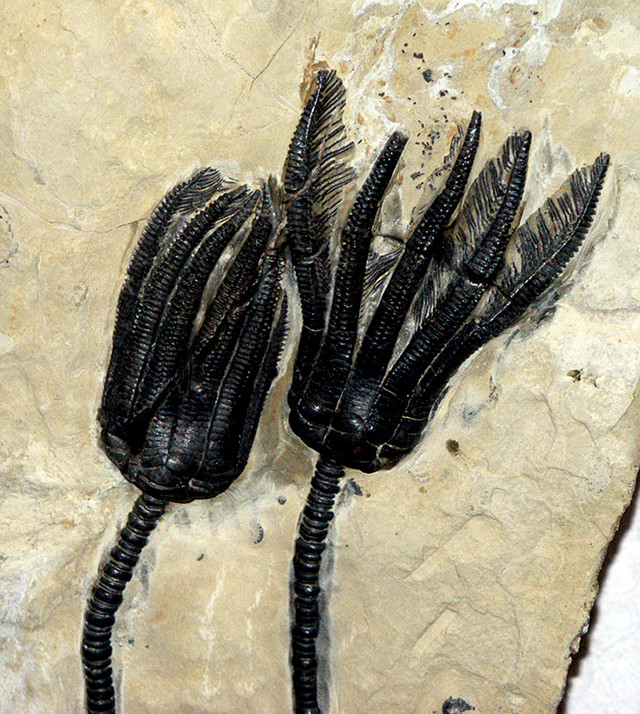
by Terri Cook Wednesday, March 2, 2016

Some crinoids became prey for parasitic sea snails and worms beginning in the Late Ordovician. Credit: Berengi, CC BY-SA 3.0
Parasitism — an ecological relationship in which one species benefits at the expense of its host — is common among living organisms, but as most parasites are soft-bodied, it’s rare to find them preserved in the fossil record. Two recent discoveries, however, have lengthened the short list of ancient parasites.
At the annual meeting of the Geological Society of America (GSA) in Baltimore last November, researchers led by University of Cincinnati geologist Carlton Brett reported finding evidence of parasites on fossil crinoids, hard-coated marine echinoderms related to starfish and sea cucumbers that have lived in the ocean since at least the beginning of the Ordovician Period almost 490 million years ago.
Many modern echinoderms harbor numerous parasites, including worms, snails and crustaceans, on their exteriors, according to Brett. But even though parasitic interactions are of considerable importance in modern ecosystems, he says, “their significance is often underestimated in the fossil record.”
The first discovery of paleoparasitism that Brett reported was of platyceratidae gastropods, an extinct family of Paleozoic sea snails, which during the Late Ordovician began attaching themselves over the anal vents of certain crinoids to take advantage of a free meal. “We know from modern crinoids that they are so efficient at capturing suspended plankton from the water that they may be rather inefficient digesters,” Brett says.
Although Brett says he suspects this relationship did not initially harm the crinoids, there is ample evidence that, by the Devonian, the platyceratidae had become parasitic. This includes indications that some of the snails, found firmly attached over crinoids, had used their rasping tongues to drill into their hosts, along with statistical evidence that crinoids with snails attached to them were, on average, smaller than specimens of the same species without snails.
After surveying known fossils of parasite-hosting crinoids from the Ordovician, Silurian and Devonian in North America, Brett’s team also discovered that this gastropod-crinoid relationship evolved through time — crinoids, for example, developed sharp spines on their arms and crowns. “Quite dramatically, in the Devonian, a majority of the some 25 genera of hosts had spines,” he says, including “some of the spiniest crinoids ever.” Conversely, very few of the crinoids that weren’t hosts sported any spines.
In a further twist of fate, the scientists found that the platyceratid snails also developed long spines during the Devonian, a change Brett attributes to the rise of jawed fish that could crush and consume hard-shelled prey. In other words, he says, the platyceratids attached to the crinoids became tasty sitting ducks upon which the jawed predators could easily graze. Crinoid spines probably also evolved in response to the fish, Brett says, which in many cases would have gobbled up the snails’ hosts along with the snails. Regardless of the drivers, there appears to have been “a co-evolutionary trend toward increased spinosity” in the Devonian, he says.
At the GSA meeting, Brett also reported evidence of a second type of parasitism, this one involving a worm-like parasite that bored into certain species of crinoids and other echinoderms. These parasites drilled out large portions — up to 40 percent— of the crinoids’ skeletons, creating a Swiss-cheese texture. The echinoderms reacted to these intruders by producing tumor-like swellings, Brett says. This parasite-host relationship persisted more than 300 million years, from the Late Ordovician until at least the Middle Jurassic.
Interestingly, the team’s research suggests these two types of parasitism were exclusive. “The crinoids that were affected by the snails … were never crinoids that have the holes and pits [from worms] in them, and vice versa,” possibly because the gastropods helped their hosts keep the worm-like parasites off their backs, Brett said in a press release about the work. And despite the damaging effects of the parasites on the hosts, they “were never really so harmful that they killed the hosts,” he said. Both the snails and worms managed to maintain their relationship with their hosts for hundreds of millions of years before finally going extinct.
© 2008-2021. All rights reserved. Any copying, redistribution or retransmission of any of the contents of this service without the expressed written permission of the American Geosciences Institute is expressly prohibited. Click here for all copyright requests.